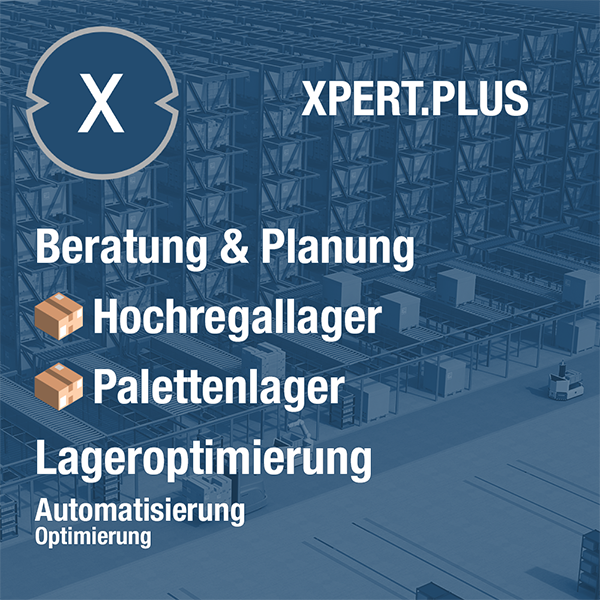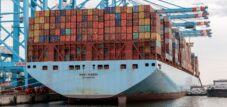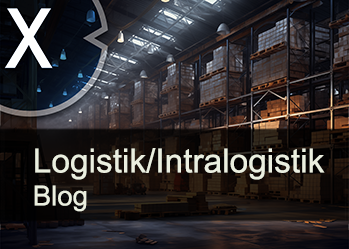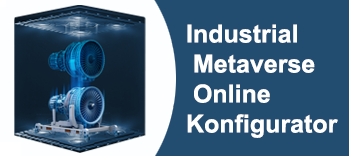The automated high-bay container storage of the Finnish crane manufacturer Konecranes and the automation specialist Pesmel
Xpert pre-release
Language selection 📢
Published on: July 23, 2025 / update from: July 23, 2025 – Author: Konrad Wolfenstein
A comprehensive analysis of the automated high-regal container camp from Konecranes and Pesmel
What is the basic challenge of traditional container storage and why are new solutions required?
The traditional method of container storage in seaports and logistics centers faces fundamental challenges that are increasingly restricting their efficiency, security and scalability. The core problem lies in the system of block stacking, in which containers with cranes or portal letters (Straddle carrier) are stacked in blocks, often up to five or six layers. This method, at first glance, creates considerable operational inefficiency. If a container is required that is at the bottom of a stack, all containers above it must first be relocated. This process, known as "Reshuffling" or "Shuffle Move", is extremely unproductive. Studies have shown that up to 60 % of all crane movements in a conventional container yard are eliminated on such unproductive implementation maneuvers.
This inefficiency is not only an isolated operational problem, but triggers a cascade of delays in the entire supply chain. An unproductive crane stroke not only means wasted time and energy for the terminal. It means that the truck waiting for the container stands still, which leads to traffic jams and longer handling times. This in turn can endanger the punctual departure of ships and delay the arrival of goods in distribution centers. The resulting unpredictability of the processes undermines the principles of modern just-in-time logistics and forces companies to maintain larger and more expensive buffer stocks in order to cushion delivery uncertainties. The removal of the reshuffling is therefore not just a question of optimization, but a strategic need to ensure the speed and resilience of global supply chains.
Another critical problem is the increasing shortage of land. Large seaports are often located in densely populated urban areas in which land are extremely expensive and hardly available. A horizontal expansion of the storage areas is therefore often economically or physically impossible. This creates a capacity bottleneck that conflicts the growing global trade volume. After all, traditional container yards are complex and potentially dangerous work environments. The intensive traffic of heavy equipment and the presence of numerous employees create a high risk of accidents that can be minimized by automation solutions. The combination of operational inefficiency, lack of space and security risks makes it clear that fundamentally new approaches are required for container storage.
Suitable for:
- The top ten of the container high-class bearing manufacturers and guidelines: technology, manufacturer and future of port logistics
What is an automated high-regal container camp (HBS) and how does it address these challenges?
An automated high-rack container bearing, often referred to as HBS (high-bay warehouse), represents a revolutionary alternative to traditional block stacking. It is a logistics system, the standard lake container – typically 20-foot (TEU) or 40-foot container (feu) – stored in a highly compressed, vertical steel control structure. You can imagine it like a huge, fully automatic bookshelf for containers. Instead of stacking on top of each other arbitrarily, each container is assigned a firm, individually addressable shelf.
The containers are deposited and out of mind fully automatically by specialized robot systems, mostly rail-guided shelves (stacker cranes), which range between the rows of shelves. The decisive advantage of this system is direct and immediate access to each individual container at any time. The time and energy-intensive "reshuffling" is completely eliminated, which means that 100 % of the crane movements are productive. This leads to a dramatic increase in envelope speed and reliability.
Space efficiency
By consistently using the vertical dimension with stacked heights of 7 to 18 layers, an HBS can accommodate the three to four times amount of containers on the same base area. This enables ports to massively increase their capacity without having to open up new, expensive properties.
Security
HBS are fully encapsulated and automated systems. The actual storage area is not entered by humans, which drastically reduces the risk of work accidents.
sustainability
The systems are usually fully electric and can be operated with green electricity. Many concepts integrate photovoltaic systems on the large roof areas and use energy recovery systems (recuperation) when braking or lowering loads. This enables CO₂-neutral or even energy-positive operation and significantly reduces noise emissions.
Perhaps the most profound change that an HBS causes is the transition from "chaotic storage" to "deterministic storage". In a traditional yard, the effort for access to a certain container is variable and unpredictable. In an HBS, the time and energy required for access to any container can be constantly and precise. This predictability is the basic requirement for effective digitization of the port processes. It enables seamless integration into overarching control systems such as Terminal Operating Systems (TOS) and the creation of more precise digital twins (digital twins). A digital twin that precisely modeled the behavior of the physical system opens up opportunities for AI-based optimization, forward-looking maintenance and the simulation of complex operating scenarios. An HBS is therefore not just a hardware solution for space problems, but a fundamental platform for the intelligent control of the entire port logistics.
Suitable for:
- The High-Bay Storage Systems (HBS) of Amova – The HBS solution of container logistics by rail-bound shelf operations devices
Who are Konecranes and Pesmel and what core competencies does every company bring into the partnership?
The partnership behind the Automated High-Bay Container Storage (AHBCS) combines two Finnish technology specialists, whose skills complement each other strategically in order to create a comprehensive solution for the automated container storage market.
Konecranes profile
Konecranes Oyj, with its headquarters in Hyvinkää, Finland, is a worldwide leading group in the field of hoists and crane technology. The company, which can trace its roots until 1933 as part of the Kone Corporation and became an independent company in 1994, is one of the largest crane manufacturers in the world and produces about every tenth crane worldwide. With around 16,800 employees in over 50 countries, Konecranes achieved record sales of 4.2 billion euros in 2024. The business is divided into the three areas of industrial equipment, service and port solutions.
The Port Solutions division is of central importance for the partnership. It offers a complete range of container handling devices that are used in ports and terminals around the world. This includes Ship-to-Shore (STS) cranes, rubber tires (RTG) and rail-bound (RMG) portal cranes, straddle carriers and reach stacker. Konecranes has proven expertise in the automation of these systems, as the successful implementation of automated RTG (ARTG) and RMG systems (ARMG) shows in leading terminals. The company is investing strongly in research and development, which is underpinned by the "Zero4" innovation program and more than 1,700 active and registered patents. Konecranes thus brings its global market presence, its established customer relationships in the port sector and his deep understanding of the requirements of the container handling into the cooperation.
Pesmel profile
Pesmel Oy, founded in 1978, is a highly specialized company for automated material flow systems. The company has concentrated on demanding industries such as paper, metal and tire industry, in which heavy and bulky goods have to be handled with high precision and speed. The core offer of Pesmel is the "Material Flow How®" concept, an integrated approach, handling, packaging, storage and logistics combines a seamless overall solution.
A key technology from Pesmel is the automated high -bay warehouse, which is often based on the principle of the "Deep Lane Storing" and enables exceptionally high storage density. Pesmel provides turnkey systems that include a proprietary warehouse management system (WMS). This WMS is designed to integrate seamlessly into the overarching company resource planning (ERP) and production management system (MES) systems of customers and can also control devices from third-party providers. With over 400 delivered systems worldwide, Pesmel has decades of experience in development of long -lasting (up to 50 years of life cycle) and energy -efficient automation solutions. As a private company, Pesmel brings its specialized automation technology and software competence to alliance, which has been tried and tested in the heavy industry.
The partnership
The cooperation, which was officially announced in January 2022, is based on a Memorandum of Understanding in November 2021. It is a strategic symbiosis that enables both companies to advance faster and with less risk into the emerging market for container high-class bearings than would have been possible for everyone. For Konecranes, the partnership offers immediate access to a proven high-bay warehouse technology without having to go through a lengthy and risky in-house development process. You can use your global sales and service structure to market a finished solution. For Pesmel, the cooperation is a “Force Multiplier”: You will receive immediate credibility and access to the global harbor market from the Konecranes brand, which would otherwise be difficult to tap. Konecranes brings the market power and port know-how, while Pesmel delivers specialized automation technology. The marketing statement that it is not a "radical new technology" is a clever positioning that builds on this synergy: it is the proven industrial automation of PESMEL, applied to the port environment dominated by Konecranes.
What are the main technical components and functions of the automated high-regal container camp (AHBCS)?
The automated high-rack container bearing (AHBCS) is a holistic system that consists of several closely integrated main components to ensure fully automatic, efficient and safe container storage operation. The architecture combines robust steel structures with advanced crane technology and intelligent software control.
System components
Steel control structure
The basis of the system is a massive high-shelf steel structure, which is provided with a roof and a side line to protect the stored containers from weather influences. This structure can be realized in two ways: as a free-standing shelf within a separate building envelope or as a building-bearing construction (Rack-Supported Building), in which the shelf itself is part of the load-bearing building structure – a construction method that Pesmel has already successfully used in other industries. The constructions are designed for an exceptionally long lifespan of 50 years and are precisely calculated and manufactured taking into account local conditions such as temperature fluctuations, wind and snow loads and seismic requirements.
Handling equipment
The heart of the material movement in the AHBCs are fully automatic, electrical bridge cranes (Overhead Traveling Cranes), which are responsible for the storage and outsourcing of the containers into the shelf subjects. Instead of traditional, massive shelf operating devices that serve an entire alley, the concept seems to rely on a more flexible system of fast-moving shuttle cranes. These shuttles or "Shuttle Load-Carrying Devices" move within the shelf alley and can dynamically adapt their distance to different container sizes, for example to handle 20-foot or 40-foot containers. These shuttles work in a network with central lifting devices (lifts) that take over the vertical transport. This architecture, which is designed for speed, flexibility and redundancy, reflects Pesmel's experience from high-performance intertraogistics. A failure of a single shuttle does not paralyze the entire alley, but only reduces the overall throughput, which increases system availability.
Container exchange zone
There is a dedicated zone for the interface to the land -side traffic (truck). Here the containers of separate bridge cranes, which are equipped with spreader, are loaded and unloaded. This area is decoupled from the actual high-bay warehouse to ensure a smooth and fast truck envelope.
Control system (WMS)
The brain of the entire system is a central warehouse management system (WMS) that coordinates and controls all processes. This is a core competence of Pesmel. Their proprietary WMS is designed to integrate seamlessly into the IT landscape of the customer, especially in corporate resource planning (ERP) and production management system (MES) systems. The actual machine control on the lowest level is carried out by proven storage-programmable controls (SPS/PLC) of manufacturers such as Siemens (SIMATIC) or Rockwell (Allen-Bradley). An essential part of the Pesmel approach is the intensive use of simulation and digital twins. These tools are already used in the planning phase to validate the system layout, identify bottlenecks and virtually into operation the WMS functionality before the first steel carrier is installed.
Intelligent container buffer camp
Which specific features, such as stacking height and cover speed, are characterized by AHBCs?
The AHBCs of Konecranes and Pesmel is defined by a number of specific performance features that position it for use in modern logistics and distribution centers. These characteristics concern the physical dimensions, operational speed and the ability to meet special requirements.
Stacking height
The system is designed for a remarkable stacking height of up to 14 layers. This enables extremely high storage density and maximizes the capacity on a given floor area. Compared to other systems on the market, the AHBCS positions itself in the upper area. For example, it exceeds the Boxbay system, which is designed for 11 layers, but lies below the theoretical maximum heights, which is called by providers such as ZPMC (up to 18 locations) or amova (structures up to 50 meters high).
Access time and throughput
The speed is a decisive promise of performance. The system enables direct access to each individual container in less than 5 minutes. This fast and above all predictable access time is a fundamental advantage over traditional yards. In combination with the elimination of unproductive surrounding processes, the system should enable a throughput of up to 75 % higher. The truck replacement time ("Turnaround Time") is reduced to a few minutes, which prevents traffic jams in the terminal area and drastically improves the efficiency of the country-sided logistics.
Load capacity and temperature range
The system is designed for the handling of containers with a payload of up to 18 tons. However, a characteristic, which is particularly emphasized, is its ability to be operated in chilled environments at temperatures of up to -28 ° C. The combination of these characteristics, in particular the ability to store cool containers (reefer) at extremely low temperatures, positions the AHBCS as a highly specialized premium solution. While the storage of standard dry containers is a margin weakness, the handling of reefer containers places higher technical requirements (e.g. on energy supply, temperature monitoring, material resistance) and is associated with higher margins. The ability to work at -28 ° C is a significant technical challenge in terms of material briefing, lubrication and reliability of the electronics and represents a clear distinction feature in the market. This not only aims at the mass storage of dry freight, but in particular on value -adding logistics chains, as can be found in the pharmaceutical or food industry. In these sectors, the reliability of the warehouse system has a direct influence on the value of the stored goods, and a system failure could mean the loss of goods worth millions. This justifies the higher investment costs and not only positions the AHBCs as a space saver, but as an integral part of a quality -assured cold chain.
Suitable for:
- The simple and evolutionary-grown idea of the container base camp: a paradigm shift in global logistics
To what extent is the direct connection to distribution centers a unique selling point of the AHBC?
A central and innovative feature that the AHBCs of Konecranes and Pesmel takes away from many other HBS concepts is the explicitly intended direct connection to adjacent distribution centers or production halls. This seamless integration goes beyond the pure optimization of warehousing in the port and creates a new level of supply chain integration.
The concept provides to be physically docking the high -bay warehouse directly to the loading lamps of a goods camp or a factory. This enables so-called "Ware-Zur-Halle" scenarios. A container arriving from the ship or truck is not only stored in the HBS, but can also be transported directly to the correct gate of the adjacent building if necessary and without further manual interventions. This approach eliminates the traditional intermediate step, in which a container from the yard warehouse via truck must be driven to the distribution center. The advantages are obvious: considerable savings in time, transport costs and CO₂ emissions. This seamless connection between the logistics of the incoming and outgoing containers and the internal distribution processes is a core sale of the AHBC.
This feature is fundamentally shifting the function of the HBS. It changes from a passive "buffer camp" in the harbor to an active "sorting and sequencing center" for the customer's intralogistics. It becomes the physical manifestation of a fully integrated supply chain. A traditional HBS optimizes the processes of the port operator; The container is handed over to him and picked up later. The AHBCs with direct connection extends the control and optimization area of the system to the customer's loading ramp.
The expertise of Pesmel plays a crucial role here in the field of industrial material flow control. Your warehouse management system (WMS) is designed to control complex material flows in factories. It can therefore not only manage where a container is located, but also, based on the customer's production or picking plans, can decide exactly when this container is required on which specific dock. This enables real just-in-time delivery directly from the ship warehouse to the production line.
This functionality fundamentally changes value creation. The customer no longer only buys storage space, but an "on-demand container delivery service" directly to his work gate. This makes the AHBCs particularly attractive for companies with large logistics or production facilities near the port, such as large retailers, automobile manufacturers or e-commerce giants. It enables you to link your internal logistics processes directly and without media breaks with global maritime traffic and thus achieve a new level of efficiency and predictability.
How does the AHBCS position itself compared to competing systems?
The market for automated high-regional container camps (HBS) is still young, but already shaped by several top-class providers with different technological approaches and strategic focus. The AHBCs of Konecranes and Pesmel position itself in this competitive environment with a unique combination of proven technology and an innovative integration concept.
A comparative analysis of the main actors shows the different profiles:
Boxbay (Joint Venture from DP World & SMS Group): This system, which is already in use in Jebel Ali, Dubai, stacks up to 11 locations. It uses fully automatic shelf control units and places a strong focus on maximum space savings (same capacity on a third of the area) and sustainability, including the installation of solar systems on the roof. The main focus is on optimizing terminal operations for the port operator.
Amova (part of the SMS Group): Amova brings its decades of experience from the metal industry and specializes in HBS for extremely heavy loads (up to 50 tons). Your systems can theoretically reach heights of up to 50 meters and use very robust, rail -guided shelves (Stacker Cranes). The theoretical storage density is extremely high with over 160,000 TEU per hectare and year.
LTW intralogistics (part of the Doppelmayr Group): This Austrian provider is known for tailor-made intralogistics solutions. They also offer container HBS for loads up to 18 tons and, like the AHBCS concept, have special expertise in the construction of frozen bearings (up to -28 ° C).
ZPMC (Shanghai Zhenhua Heavy Industries): The Chinese giant in port plant construction develops an "automatic stereoscopic empty container bearing" for the port of Ningbo-Zhoushan. This system stacks 9 and initially targeted the specific but voluminous market segment of the empty containers.
The following table summarizes the most important features:
The AHBCS compared to competing systems
Compared to competing systems, the automated high-shelf container camp (AHBCS) from Konecranes and Pesmel shows some remarkable properties. It particularly stands out with a maximum stack of 14 layers and the use of shuttle cranes and lifts. A unique selling point is the direct connection to distribution centers and the ability to store up to -28 ° C at extremely low temperatures.
Other providers such as Boxbay also rely on high-bay warehouse concepts and can triple the storage capacity on the same area, putting a special focus on sustainability. Amova, in turn, specializes in high -performance solutions with shelf operating devices that can master heavy loads of up to 50 tons and enable storage levels up to 50 meters.
LTW Instalogistics offers flexible container storage systems with tailor -made solutions, while ZPMC focuses on storing empty containers in a stereoscopic system with rail -bound cranes. Each provider brings their own technological innovations and specializations into the market of automated warehouse systems.
From this comparison it becomes clear that the HBS market is segmented in various applications. While Boxbay and Amova primarily concentrate on maximizing the density and throughput within the terminal and ZPMC uses a niche segment, the AHBCs from Konecranes and Pesmel are unique at the interface of port logistics and industrial intralogistics. Your “Ware-Zur-Halle” concept addresses a hybrid customer: the port operator and the owner of the adjacent distribution center. You not only sell a warehouse solution, but an end-to-end delivery chain solution. This positioning is a great opportunity because it promises higher potential for value and deeper customer loyalty. At the same time, it represents a challenge because the projects require complex coordination between several stakeholders (port, logistics company, end customer).
Container handling 4.0: The smart path to the ultra-functional port logistics
What quantifiable advantages does the AHBCs offer in terms of area efficiency, operating costs and throughput?
The automated high-rack container bearing (AHBCS) promises a number of significant and quantifiable advantages that have a direct impact on the economy and performance of logistics operations. These advantages concern the three core areas of space efficiency, operating costs (opex) and throughput.
Space efficiency
The most dramatic advantage is to reduce the space requirement. Due to the consistent vertical storage in up to 14 layers, the system can reduce the space required for containers by up to 80 %. This massive area saving has far -reaching strategic implications. It enables ports and distribution centers to significantly increase their capacity on existing terrain, without buying expensive and tight plots or having to move to another location. The country, one of the largest cost centers, is therefore used much more efficiently.
Operating and investment costs (Opex/Capex)
Konecranes emphasizes that the AHBCs leads to lower overall operating costs (Capex/Opex). This results from several factors. On the Opex page, the complete elimination of unproductive surrounding movements leads to a drastic reduction in energy consumption. The fully electric drives are naturally more efficient than diesel unit and can be further optimized by energy recovery systems. A case study by Konecranes from another industry illustrates the potential: after installing new, more efficient cranes, the maintenance -related costs decreased by 80 % and the total electricity consumption of the system by 12 %. Automation also reduces the need for surgical staff. On the Capex page, investments in the technology may be high, but these are compensated for by the massive savings on the property costs and the potentially lower number of handling devices required compared to a conventional yard.
Throughput and efficiency
The system is designed for maximum performance. Since 100 % of the movements are productive, an increase in total throughput is forecast by up to 75 %. One decisive advantage is that this performance is predictable and constant, regardless of the level of filling of the warehouse. In traditional yards, performance often breaks down with high levels of filling, since the likelihood of elaborate surroundings increases. The AHBCS, on the other hand, retains its high envelope speed. This leads to drastically shortened truck handling times, which eliminates traffic jams in the yard and improves the efficiency of the entire logistics chain as a country.
However, the real financial lever of the AHBC lies not only in direct cost reduction, but also in increasing plant productivity and the development of new sources of income. The 80 percent reduction in surface means that a port operator can use the free space for other, more value-added activities, such as logistics services, repair centers or even additional berths. The country becomes a productive asset from a pure cost center. At the same time, the higher and, above all, predictable throughput enables more ships to be made in a shorter time and also more efficient to operate the ever larger Ultra Large Container Ships (ULCS). This directly increases sales per berth and per square meter terminal area. A comprehensive cost-benefit analysis must therefore go beyond a pure Capex/Opex comparison and quantify these strategic advantages that represent an investment in growth and long-term competitiveness.
Suitable for:
What are the potential challenges and risks when implementing an AHBC?
The implementation of a complex, highly automated system such as the AHBC is associated with considerable challenges and risks that go beyond purely technical aspects. Careful planning and comprehensive risk management are essential for the success of such projects.
High initial investment (Capex)
The construction of an automated high -bay warehouse is extremely capital -intensive. The costs for massive steel construction, precise crane technology, automation hardware and the complex control software are a significant financial hurdle. Financing and long -term amortization of this investment must be carefully planned.
System complexity and integration
The technical complexity is enormous. The seamless integration of the HB into existing IT infrastructures of the customer, such as the Terminal Operating System (TOS) or the company resource planning (ERP) system, is a critical challenge. This requires intensive cooperation and coordination between the provider (Konecranes/Pesmel) and the internal IT and business team of the customer to avoid data inconsistencies and interface problems.
Maintenance and technical failure safety
As with any high -tech system, technical problems or failures can lead to costly downtimes. An HBS requires regular, planned and preventive maintenance to ensure high system availability. Providers such as Pesmel encounter this risk with comprehensive service and maintenance contracts that often contain 24/7 support. Nevertheless, the risk of an unforeseen failure of a critical component remains.
Fire protection and insurance
Automated high -bay bearings represent a significant fire risk. The high bearing density, the enormous fire loads within the containers and the proximity of electrical ignition sources (motors, electronics) to potentially flammable materials require highly developed fire protection concepts. This typically includes sprinkler systems in every single shelf channel, smoke and heating painters as well as a clear strategy for the fire. Insurers see these risks very precisely and often demand strict requirements. This can lead to high insurance premiums. The greatest financial risk is the potential operating interruption after a major fire, since the restoration of such a complex system can take an extremely long time.
Limited operational flexibility
An HBS is optimized for certain parameters defined in advance. It may be difficult to react flexibly to unforeseen changes, such as a sudden, massive increase in containers with different dimensions or weight classes if these have not been taken into account in the original design.
Perhaps the largest, often underestimated risk is not technical, but organizational nature. The introduction of an AHBC requires a fundamental change in operating philosophy – from reactive, manually controlled processes to proactive, fully data -controlled processes. A traditional container yard is often managed reactively; Problems are solved when they occur. A fully automatic HBS, on the other hand, requires that all relevant data – from ship arrivals to truck time windows to the exact container retention – are correct and available in advance in the system. The principle "Garbage in, Garbage Out" applies to an extreme extent. An error in the input data can interfere with the entire automated logic chain. This requires a cultural change in the entire company: planning processes must be more disciplined, data quality flawless and the cooperation between the departments (company, IT, sales) must be seamless. A failure of the implementation is therefore often less due to a technical error in the crane than on an error in the organizational process that "feeds" the system. The investment in an AHBCS is therefore inextricably linked to an investment in digital transformation and the change management of the entire company.
How is the AHBCS concept positioned to integrate into future “intelligent port” ecosystems?
The concept of the automated high-shelf container bearing (AHBCS) is not only an answer to today's challenges of port logistics, but is designed from scratch to the fact that it fits seamlessly into the future "Smart Port" ecosystems and even actively helps shape them. A “Smart Port” uses a network of digital technologies such as the Internet of Things (IoT), big data, artificial intelligence (AI) and digital twins to automate processes, maximize efficiency and improve sustainability.
The AHBCS is essentially a cyber-physical system and thus a born part of a smart port. His central warehouse management system (WMS) acts as an intelligent data hub that is designed to connect with every overarching terminal operating system (TOS) and to exchange data. The simulation models and digital twins intensively used by Pesmel in the design phase form the perfect basis for creating an operational digital twin of the warehouse during ongoing operation. Such a digital twin – a virtual real-time replica of the physical warehouse – enables to monitor, analyze and optimize operations. It can be used for forward -looking maintenance by recognizing wear patterns before a failure occurs. He can feed AI algorithms with data to develop optimal warehouse strategies, or it can be used to simulate disorders and to train personnel.
In addition, the AHBCS fits perfectly with the sustainability goals of modern ports ("Green Port Initiatives"). Its fully electric design, the possibility of integrating solar energy on the large roof areas and the significant reduction in noise and local emissions contribute directly to decarbonization and improving acceptance in urban environments.
Ultimately, the AHBCs is not just a passive participant in a smart port, but an active pioneer. It solves the basic problem of the physical disorder and unpredictability of a traditional container yard. It is extremely difficult to apply effective AI optimizations or a precise digital twin to a chaotic system whose processes and data are unreliable. The AHBCs, on the other hand, create a controlled, laboratory -like environment on an industrial scale. Every movement is recorded digitally, every condition is known, every process time is measurable and predictable. This structured and data-rich environment is the "data gold mine", which serves as a fuel for advanced digital applications. Based on this perfect data, a AI can learn to optimize storage strategies – for example by automatically placing containers that will soon be required near the outputs – or minimizing energy consumption by intelligent control of the crane movements. The deterministic and automated nature of the system also creates the precise and predictable interfaces that are absolutely necessary for the integration of future technologies such as autonomous truck fleets or automated guided vehicles (AGVS). The investment in an AHBCS is therefore not only an investment in steel and cranes, but also in the creation of high -quality data infrastructure that multiplies the value of future investments in AI and digitization.
What is the final expert assessment on the potential and market position of the AHBC of Konecranes and Pesmel?
The automated high-regal container camp (AHBCS), which emerged from the strategic partnership between Konecranes and Pesmel, represents a highly competitive and well thought-out solution in the up-and-coming but still young market for automated container camps. derive.
The strength of the offer is undeniable in the credible combination of the respective core competencies of the partners. Konecranes brings its global market power, its decades of experience and his established customer relationships in the port sector. Pesmel provides the technological substance in the form of a tried and tested automation technology for high-bay warehouse, which has been tried and tested in the heavy industry, completely with a highly developed software and control level. This symbiosis minimizes the development risk and maximizes the market entry speed.
The decisive unique selling point of the AHBC is the "Ware-Zur-Halle" concept. By closing the physical and procedural gap between port logistics and intralogistics from distribution centers or production facilities, it addresses a new, hybrid market. It moves the focus from pure storage position optimization to the creation of a seamless end-to-end supply chain solution. In combination with the specific technical performance features, in particular the ability to store cool containers at -28 ° C, the AHBCs clearly position itself in the premium segment for value -adding, quality -sensitive logistics chains.
The biggest challenges for a broad market acceptance are the high initial investments and the immense organizational complexity of the implementation. An AHBCS project is not an easy sale of standard equipment; It is a profound transformation project that requires a fundamental change in the company processes and the customer's corporate culture.
In summary, it can be said that the success of the AHBC will depend less on the pure technological superiority – since the competition also has strong offers – as the ability of Konecranes and Pesmel, to successfully manage these complex, turnkey projects. A project that integrates the systems and processes of a port, a logistics center and possibly a production hall is more complex than the installation of devices in a closed terminal area. It requires profound advisory, planning and project management skills that are more like those of a large IT system integrator than those of a traditional mechanical engineer. The partnership must prove that it can not only deliver hardware and software, but also a seamless, integrated project processing from the first simulation to long -term maintenance and optimization. The market position of the AHBC is therefore technologically and strategically strong, but its ultimate success will depend on excellence in the execution and management of these transformative projects. It is a test not only for technology, but for the strategic alliance itself.

Xpert.plus warehouse optimization – high -bay warehouse such as pallet warehouse advice and planning
We are there for you – advice – planning – implementation – project management
☑️ Our business language is English or German
☑️ NEW: Correspondence in your national language!
I would be happy to serve you and my team as a personal advisor.
You can contact me by filling out the contact form or simply call me on +49 89 89 674 804 (Munich) . My email address is: wolfenstein ∂ xpert.digital
I'm looking forward to our joint project.































